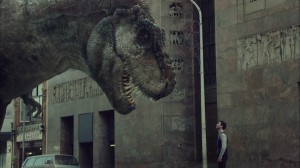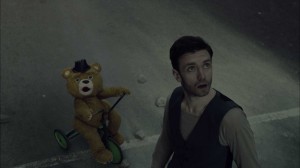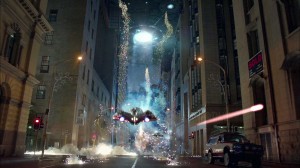
Director Adam Berg and ad agency CHI & Partners recently turned to London-based VFX facility MPC to create an epic spot portraying the features of Samsung’s new Smart TVs, which can be controlled with voice recognition and motion sensors. In the 1:30 spot, entitled “King of TV City,” a fearless viewer faces a herd of wildebeest, a tyrannosaurus rex and a space age assault. MPC worked closely with Berg on a 10-day shoot in Cape Town where the team worked with an animal park, racing drivers and set off explosions in the street.
“I had the pleasure of working with MPC on the very VFX-heavy ‘King Of TV’ and it was a great experience,” said Berg. “It was never going to be an easy job and there was no frame in the film that was not worked on in some capacity.”
VFX supervisor Franck Lambertz and CG supervisor Christopher Antoniou led the team on this ambitious project, harnessing MPC’s talent around the globe. With the majority of the work completed in London, Mark Gethin completed the grade in L.A., the 3D department in NY helped to craft the wildebeest and the Bangalore studio assisted with rotoscoping and tracking.
 “This job really showcased what we are capable of as a company,” said Lambertz. “It combined all of our disciplines – concept design for the T-rex and spacecraft, CG and 3D, matte painting, greenscreen and everything in between. By utilizing our teams across the globe we were able to complete this film and all its jaw-dropping action in a relatively short amount of time.”
“This job really showcased what we are capable of as a company,” said Lambertz. “It combined all of our disciplines – concept design for the T-rex and spacecraft, CG and 3D, matte painting, greenscreen and everything in between. By utilizing our teams across the globe we were able to complete this film and all its jaw-dropping action in a relatively short amount of time.”
One of the first tasks for the team was to create the setting. Trees were removed from the street and buildings were enhanced to give the look of a generic modern city. Creating a claustrophobic feel was key to setting up the first piece of action. “We shot a herd of wildebeest on a massive greenscreen, working in a safari park just out of Cape Town,” explained Lambertz. “This was challenging to say the least, as wildebeest aren’t exactly the most co-operative animals.” Once enough footage was shot, the team used MPC’s proprietary crowd replication software to build the scene.
MPC’s team of concept artists designed the tyrannosaurus rex, which was then sculpted in 3D using ZBrush. This was vital as it depicted its final shape and form, allowing the team to measure the impact point precisely on the wall. The wall that is destroyed by the creature is part miniature build and part CG.
“Following the sculpt in ZBrush, we extracted vendor displacement, which allowed us to keep the rig geometry nice and light, in turn making the animators life easier,” explained CG supervisor Antoniou. “The T-rex had an automatic tail system, with muscles and proprietary jiggle deformers, which was originally developed for MPC’s film pipeline.” The compositing team added debris and saliva to the dinosaur, further adding to the realism.
 The racing car shot was captured in camera and driven by real racing drivers. The team added the wind effects and composited the protagonist, who was shot on greenscreen, into the scene, blending the shots together. The bear was a puppet, whose rig was removed and had his eyes animated to give him a higher level of anthropomorphism.
The racing car shot was captured in camera and driven by real racing drivers. The team added the wind effects and composited the protagonist, who was shot on greenscreen, into the scene, blending the shots together. The bear was a puppet, whose rig was removed and had his eyes animated to give him a higher level of anthropomorphism.
To create a great deal of the action, the entire street was shut down for the shoot for several days. The final, epic scene showing a space age assault was a combination of live action and CG footage. Referencing films such as Independence Day and Alien, the concept artists turned their hands to designing the mothership and UFOs. These were then fully produced in 2D in Maya. As the crafts start to shoot fireballs, MPC’s extensive element library was used to add to the flame and smoke effects.
The car flipping onto its side during the action was captured in camera, as were many of the explosions and fireballs, then further enhanced in Maya. Five cameras were used, mounted on buildings and cars to help capture the epic scene.
MPC’s Motion Design studio was enlisted to create the television interface and end shot. The interface was created in Adobe After Effects, then composited into the TV itself in Flame.
The grade was completed by Mark Gethin, who helped to seamlessly capture the changes in mood and atmosphere.





